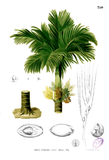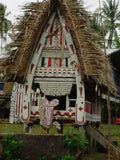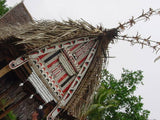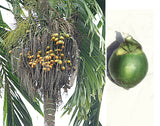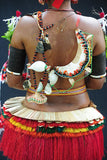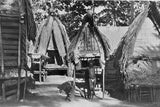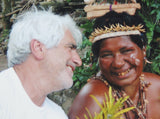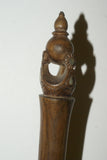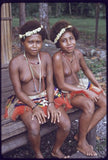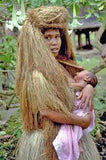RARE VINTAGE MELANESIA MASSIM TROBRIAND ISLAND BETEL LIME POUNDER WITH PESTLE SET, VERY ORNATE CARVING WITH PATINA & MOTHER OF PEARL INSERTS (MID 1900’S) BP4
MID 1900'S COLLECTIBLE, POSSIBLY 1970’S
The lime pounders and containers of the Trobriand Islands are among the most collectible carvings in Oceania. Lime spatulas, pounder and receptacles are related to the betel nut chewing habit and are of great importance in the Massim area.
Papua New Guinea, Trobriand Islands: These hand-carved wooden betel receptacles with pounder or pestle included, were each finely carved and adorned with incised stylized geometric details and inserts of mother of pearl.
This elaborate large vintage set, BP4, is unique and so detailed and belonged to the chief of the village, very nice hand carved wood (good patina) with incised geometric motifs and inserts of mother of pearl, ornate hand carved motifs on the pestle as well as the cup. Measures: 16 3/4" x 3"
Please inspect photos carefully to be satisfied, pictures speak louder than words.
The practice of betel nut chewing actually involves the chewing of three substances together: the nut of a palm (which purportedly tastes similar to nutmeg); the leaf, bean, or stem of the betel vine, which is a member of the pepper family; and hydrated or slaked lime (from burned seashells or coral or from mountain lime).
Betel chewing is part of working in the gardens, attending feasts, meeting friends, trade rituals, and making love for the people of East New Guinea and the Trobriands.
A traditional part of a man's personal paraphernalia in New Guinea and the Trobriands was his lime container and the spatula for betel chewing, a custom practiced on social and ritual occasions.
Three substances are actually chewed together: the nut of a palm, which has a hot, acrid taste similar to nutmeg; the leaf, bean, or stem of the betel vine, which is a member of the pepper family; and slaked lime made from burned sea shells or coral or from mountain lime and kept in this container while not in use. Once chewed, the mixture becomes a mild stimulant said to reduce hunger, pain, create a sense of well-being, and increase a person's capacity for work. Chewing betel nut makes people teeth turn red and eventually rot.
The Massim district from which these lime implements originate consists of the southeastern tip of New Guinea, the Louisade Archipelago, the D'Entrecasteaux Islands, and the Trobriand Islands. There is much trade between the islands; both ceremonial trading, called hula in which shell-disc necklaces and shell armbands are exchanged, and utilitarian, in which canoes, clay pots, wooden bowls, pigs, food, betel-nuts, and betel chewing utensils are traded. Betel chewing plays an important role in the hula. Lime spatulas are sometimes offered to get the trade partner to yield the desired hula item and the power of betel chewing is also used to influence trading.
Compare at $500.00 and up for older ones such as these at auction. I have seen one go at a New York SOTHEBY AUCTION for $1,000.00
All our collector and rare items come with pages and pages of research about provenance, and with history of the tribes and photos as well, depending on item and whenever possible. When shipping internationally, we group ship multiple purchases to save you money, and find the best rates available. If you have any questions or want to see research conducted on these pieces, let us know.

































































